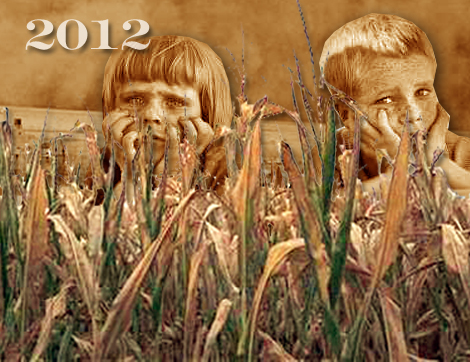
This Drought Has Worldwide Ramifications
By Victor Thorn
For six years during the 1930s, America suffered such severe drought conditions that the Midwest portion of our country became known as the Dust Bowl. Coupled with the Great Depression, people actually felt that Armageddon had descended upon them as vast clouds of what used to be topsoil blew across the plains and blanketed entire cities from the Midwest all the way to Boston.
Some say the drought America is facing today could be even worse, once the dust settles. An unending string of triple-digit temperatures has already caused municipalities across the country to take drastic steps to preserve water supplies. June was the third-driest month on record in 118 years. 63% of the contiguous U.S. is in a state of moderate to severe drought, according to the University of Nebraska-Lincoln’s National Drought Mitigation Center (NDMC). The Department of Agriculture has declared disasters in 26 states. No other calamity, including the horrendous 1936 heat wave, has covered such a widespread area. With heat records smashed in over 4,500 locales, experts, farmers and everyday citizens are beginning to speak in the same apocalyptic terms as were used 80 years ago.
Across the country, town councils have been banning lawn sprinklers, closed car washes and shuttered public swimming pools. In other areas, the measures are much more dramatic. One Texas community resorted to opening fire hydrants with pumping machines so that thirsty residents could get water.
Farmers face even bigger hurdles. With ponds and streams drying up, ranchers have been running electric well pumps non-stop so that thirsty livestock can drink, resulting in soaring electric bills.
Even America’s mightiest waterway, the Mississippi River, has been affected. This summer, the big river reached alarmingly low levels. Near New Orleans, the Army Corps of Engineers warns that in the delta area, salt water from the gulf has been washing so far upriver it is endangering the region’s freshwater supplies.
On July 19, this writer spoke with Mark Svoboda, a climatologist at NDMC. Svoboda described the magnitude of our current hardships.
“We’re looking at the largest geographically extensive drought since the 1930s” said Svoboda. “64% of the U.S. is in some form of drought, and there’s been an uptick in severity that was exacerbated by the latest heat wave.”
Svoboda tried to put the matter into perspective. “The last time a huge drought hit the Midwest was in 1988,” he said. “Total costs soared to $30-$40B. We’ve already surpassed the cumulative effects of that drought, and our biggest fear right now is that this current trend continues. We don’t want a multi-season drought extending over multiple years.”
It’s easy to see what kind of effects this will have on the U.S. in the not-so-distant future.
“If this drought continues, we’re going to start facing water supply issues,” said Svoboda. “We’ve already seen the impact of what a low snowpack did in the Rockies with all the wildfires. I’ve never seen a natural disaster cover such a large spatial footprint. Tornados and hurricanes are short-lived, but droughts extend well into the future.”
Clara Tuma is with the Lower Colorado River Authority, a nonprofit public utility that was created in November 1934 by the Texas Legislature to regulate water from the Colorado River.
Ms. Tuma told AMERICAN FREE PRESS on July 19: “In 2011, Texas experienced its worst single-year drought in history, and we’ve yet to recover. Reservoir lakes are still at 50% capacity, and clearly if we have another year like the last one, it would be devastating.”
As AFP has previously noted, water wars could become the 21st century’s primary battleground. March 22 marked what the UN calls “World Water Day.” In a speech on that day, Secretary of State Hillary Clinton said: “Water is integral for well being and can even pose a national security threat.”
Christiana Peppard, an assistant professor at Fordham University, took this notion a step further, saying: “Freshwater is the most significant political, economic and ethical problem that the United States and the world will face in the 21st century.”
In a July 19 article for The Christian Science Monitor (CSM), Gloria Goodsdale touched upon one other global factor. Since food exports from the U.S. will be reduced to other impoverished areas across the world, they’ll then be compelled to use more of their own water to grow crops. In arid regions such as Africa and the Middle East, the stress could lead to skyrocketing prices, political turmoil and even regional wars, as countries battle it out for access to clean water.
Sadly, forecasters don’t see much relief. A mind-boggling 82% of Missouri is in a state of drought, while some parts of Wisconsin haven’t seen any rainfall in two months. Other parts of the Eastern seaboard have had abundant rainfall, including Maine, Florida, North Carolina and Virginia.
Lack of Rain Hits Heartland Hardest
By Victor Thorn
With little or no rain and thermometers surging past the 100° mark for weeks on end, crops in America’s heartland have little chance of surviving. Ranchers are also feeling the heat as livestock struggle to find adequate nourishment in fields that are yellow and withered.
Quite possibly the single largest impact on consumers across the country—and worldwide—is the drastic effects this drought has had on America’s corn crops.
Holly Deyo of Millennium Ark, a news website that focuses on practical preparedness, explained in a July 9 article why a serious fall in corn production in the U.S. will cause prices to soar.
“Since 75% of grocery store products use corn as a key ingredient, expect food prices to skyrocket,” she wrote. “Corn is also a staple in many fast foods.”
Akin to petroleum, corn-related derivatives appear in almost everything people use—toothpaste, makeup, cough syrup, paint, vitamins, ink, fiberglass and batteries, to name only a few.
With predictions of total U.S. corn losses nearing 60%, prices are expected to rise in the coming year. But the troubles don’t end domestically. America is the world’s largest exporter of corn. Foreign nations will undoubtedly feel the pinch as farmers in Nebraska and Iowa walk across fields that crack beneath a sweltering sun. As they examine cornstalks and pull back on the husks, often they find shriveled kernels or nothing at all. Their losses are now being calculated in the billions of dollars.
At the Chicago Board of Trade, corn prices have doubled since the heat wave began, with an escalation in the cost of soybeans sure to follow. Making matters worse, the potent combination of excessive heat and negligible rainfall has produced an outbreak of fungi, Japanese beetles, spider mites and rootworms. Customers relying on wheat, corn and soybean exports in Germany, Africa, Mexico, the Middle East, China, India and Central America are bracing themselves for shortages and a spike in prices.
Corn is also a key ingredient in animal feed. As a result, the price of everything from beef to chicken to pork will soon mirror that of corn, especially since supermarket meat prices are still high from the Texas 2011 drought.
There is another matter connected to what cows will eat. The National Oceanic and Atmospheric Administration observed: “Excessive temperatures and low rainfall [have] scorched grasslands typically used for grazing. With grass scarce, hay prices become too costly.”
The University of Idaho’s Rauhn Panting echoed this sentiment: “We’re going to run out of grass. It’s going to be scary.”
Unable to afford higher-priced grain products, farmers are making a desperate plea to politicians in Washington, D.C. Specifically, they want lawmakers to put their priorities in order. Reuters reported on July 18: “Hard-hit livestock producers and other groups want the Environmental Protection Agency to give oil refiners a waiver from the mandate to blend ethanol into gasoline, arguing demand for corn-based fuel was driving up corn prices. About 40% of the U.S. corn crop is now being used to produce ethanol.”
Faced with no other options, ranchers are resorting to the inevitable: culling their cattle herds.
In the CSM article, Frank Galgano, a professor at Philadelphia’s Villanova University, related the predicament many farmers are in.
“You will start to see more foreclosures in the Farm Belt as farmers and ranchers can’t pay their bills,” he said. “These guys mortgage themselves to the hilt for their seeds and equipment, and if the crop doesn’t come in, they’re in trouble.”
Sun’s Magnetic & Sun Spot Cycles Will Peak at Same Time in 2013
By Victor Thorn
In the Midwest, Mother Nature has given us weeks of triple-digit temperatures, forcing many to focus on the blazing-hot weather and unending drought. But lurking at the center of our solar system is undoubtedly an even more powerful adversary.
In a June 14, 2010 column, Andrew Hough of the UK’s Telegraph documented a once-in-amillion “space storm.” “Senior space agency scientists believe the Earth will be hit with unprecedented levels of magnetic energy from solar flares after the Sun wakes ‘from a deep slumber’ sometime around 2013,” he wrote. NASA “said the super storm would hit like ‘a bolt of lightning’ and could cause catastrophic consequences for the world’s health, emergency services and national security unless precautions are taken.”
Could this summer’s drought be the beginning of what Hough sees as a double-whammy on the United States?
“Every 22 years the Sun’s magnetic energy cycle peaks while the number of sunspots—or flares—hits a maximum level every 11 years,” he wrote. Dr. Richard Fisher, the director of NASA’s Heliophysics division, “said these two events would combine in 2013 to produce huge levels of radiation. He said large swathes of the world could face being without power for several months.”
Nearly every aspect of the power grid would be compromised, including GPS devices, satellites, air traffic controllers, computerized banking networks and large metropolitan electrical suppliers that run hospitals or emergency services.
Fisher’s expertise brought him to the following conclusion: “Systems will just not work. The flares change the magnetic field on the earth that is rapid and like a lightning bolt. That is the solar affect.”
——
Victor Thorn is a hard-hitting researcher, journalist and the author of over 30 books.





